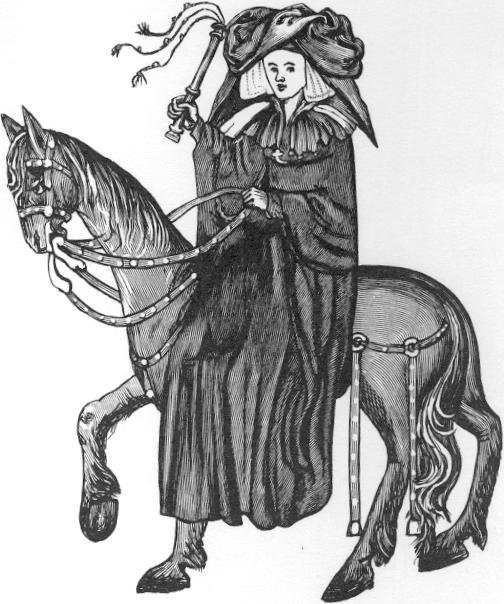The glowing sketch of the Wife of Bath is one of the most striking in the “General Prologue”: “Bold was hir face and fair and reed of hewe. She was a worthy woman al hir live” (line 466). Alisoun knows how to attract men’s attention, and she wears expensive clothes, ten pounds of cloth on her head, a large hat and a scarlet red dress. She learns that it is very important for a woman to satisfy her man, and she knows how to act to make him obedient and less powerful. As an example, the Wife of Bath fakes being murdered by her fifth husband to make him sorry for beating her and to get authority over him: “Thief, thus muchel am I wreke. Now wol I die: I may no lenger speeke” (line 815).
Over her life, Alisoun has become very experienced and knowledgeable in relationships between the sexes and she answers all questions. The Wife of Bath marries five times and is widowed five times: “Husbondes at chirche dore she hadde five, Withouten other compaignye in youthe” (line 461). The first three husbands are old, rich and loyal to her, while the last two are young and difficult. The fourth husband is unfaithful, has a mistress, and the fifth one is violent. Alisoun believes in experience rather than authority: “Experience, though noon auctoritee” (line 1). She has acquired experience through relationships with men. She is only twelve years old when she marries a much older man. Alisoun is deaf in one ear, because her fifth husband hits her after she tries to distract him from reading.
A more detailed description of Alisoun portrays her as a brave and original woman. The Wife of Bath is very open, and she talks a lot about different ways to please a man. She explains that sexual organs are designed to be used, and they are fruits in a marrage: “In th’actes and in fruit of marriage”(line 120). Alisoun believes that men owe their wives, and they should pay them back in sex: “Now wherwith sholde he make his payement. If he ne used his sely instrument?" (line 135). Alisoun does not envy virginity. She understands that if everyone was a virgin, there would be no children, and the human population would die: “I nil envye no virginiteee”(line 148). She has power over her men for their whole lives, and she mentions this often: “ I have the powere during al my life. Upon his proper body, and nat he” (line 164).
The Wife of Bath remembers her youth as the best time of her life.
She is happy that she has spent her life enjoying every minute: “
But Lord Crist, when that it remembreth me. Upon my youthe and on my jolitee”(line 475). When her husband leaves town for business, she goes out to flirt with other men, and she always wears red clothes to attract attention to herself. The Wife of Bath marries much younger men, and the age difference does not matter to her. Chaucer writes that Alisoun meets her fifth husband at the funeral of her fourth, and soon they get married.The Wife of Bath gives him all her property: “This joly clerk Janekin that was so hende. Hath wedded me with greet solempnitee, and to him yaf I al the land and fee” (line 634). In the fourteenth century, only men write books. Alisoun does not think that it is right, especially because men write about women only from their point of view. She compares this to a drawing about man fighting with a lion. Since the man paints the picture, he wins. If the lion had painted it, he would be the winner. Alisoun is very smart, and she is aware that everything depends on who tells a story: “Who painted the leon, tel me who? By God, if wommen hadden writen stories. As clerkes han within hir oratories, They wolde han writen of men more wikkednesse Than al the merk of Adam may redresse" (line 695). Alisoun is probably not literate, learning from her experience rather than from books.
The Wife of Bath mentions God often, and she explains that true nobility is not about rank or status but comes from God: “For gentilesse cometh fro God alone.” (line 1168). In her tale, Alisoun describes a love story, and she mentions that love does not have any barriers. Age really does not matter when people have feelings. Alisoun believes that we should be happy and appreciate everything we have.
The character of the Wife of Bath seems unrealistic for a fourteenth-century English woman. Alisoun is a very complicated character. She tells a lot about herself. This proud woman is aware of her sexuality and sovereignty over men. I think that her character is controversial even though I think that she is a great woman and deserves credit for her actions.